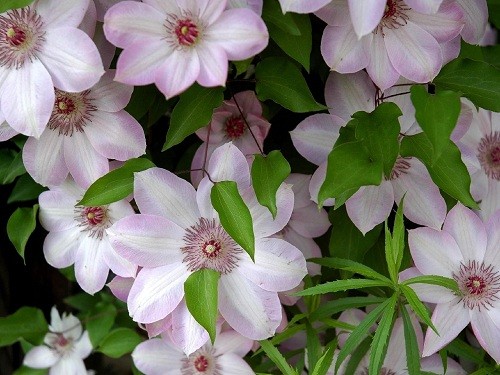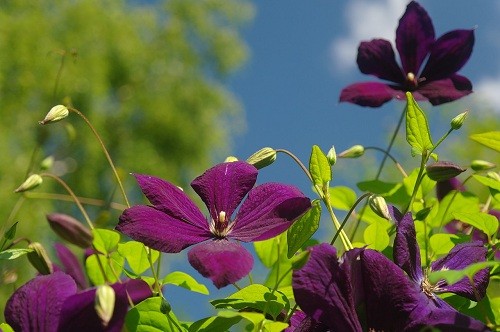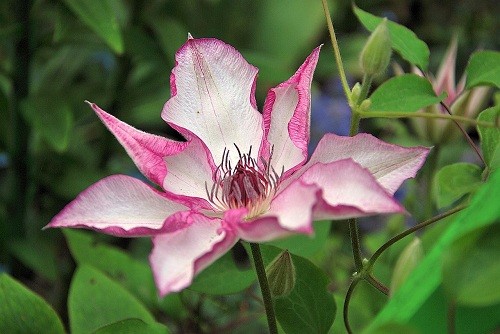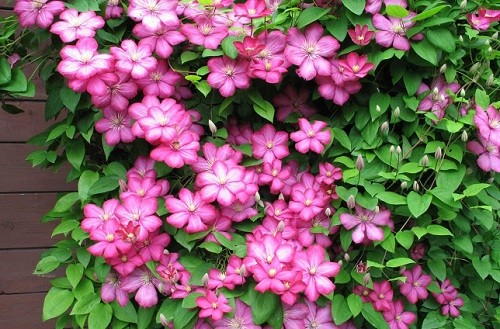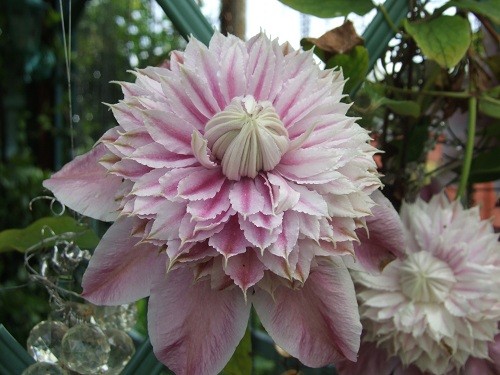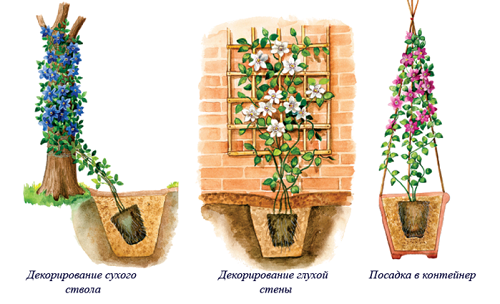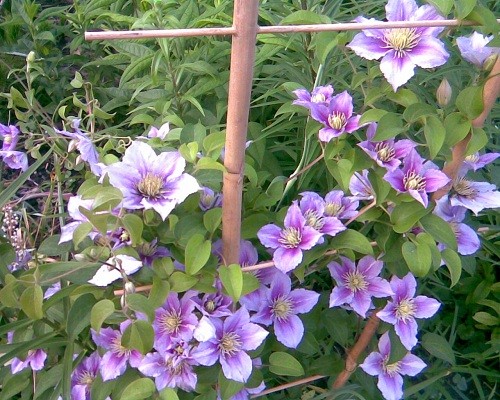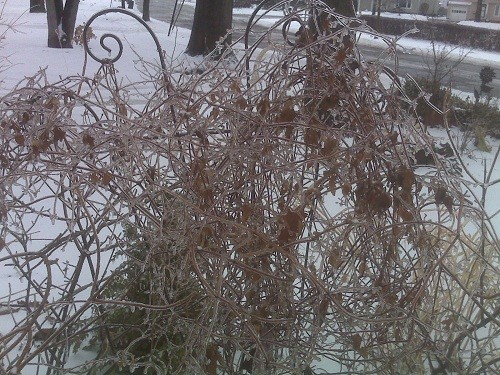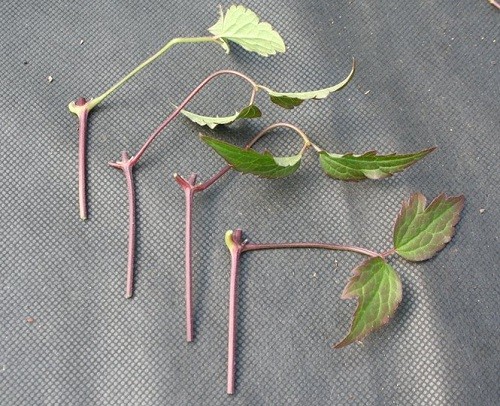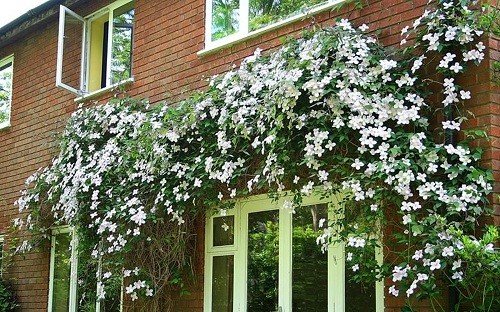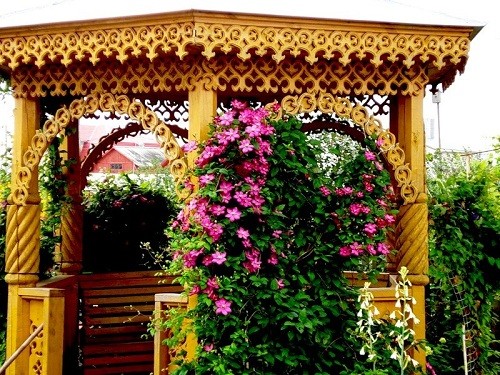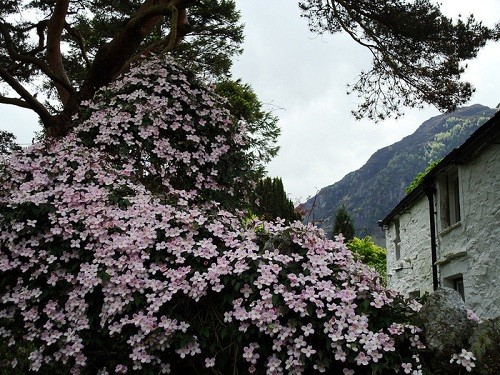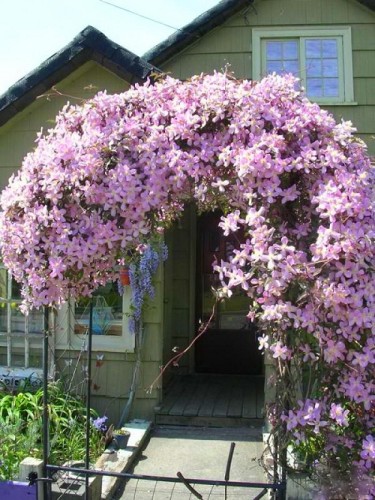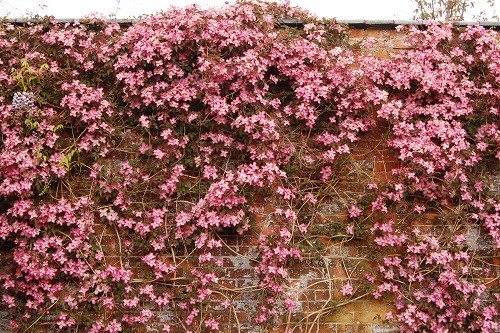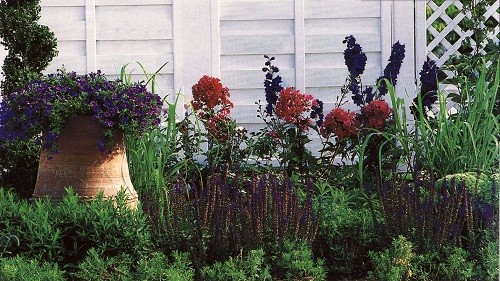
Clematis in Landscape Design: Vertical Gardening Plot.
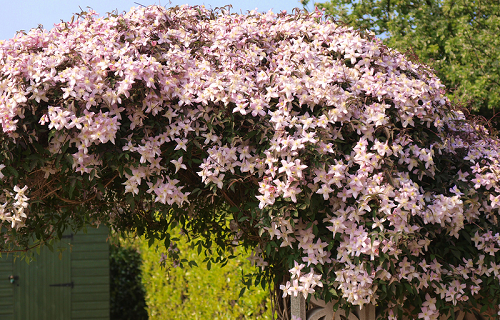
Clematis - Some of the main favorites of Dachnikov when it comes to the vertical garden landscaping. This curly liana with incredibly attractive colors becomes a bright emphasis on any subsidence. The species belonging to Clematis determines the size, color and shape of its buds. Small, medium and huge flowers of white, blue, dark purple, red and lilac colors on a fence or wall of the house - a beautiful decorative solution for dacha decorating. The article will introduce you to closer with this amazing garden resident and will tell about the peculiarities of His growing and care for him.
Content
- Clematis: All you need to know for growing plants
- Time and way to plant clematis
- Care for clematis
- yandex_partner_id \u003d 53889; yandex_site_bg_color \u003d 'fffff'; yandex_ad_format \u003d 'direct'; yandex_font_size \u003d 1.0; yandex_direct_type \u003d 'vertical'; yandex_direct_border_type \u003d 'ad'; yandex_direct_limit \u003d 1; yandex_direct_title_font_size \u003d 2; yandex_direct_links_underline \u003d true; yandex_direct_bg_color \u003d 'fffff'; yandex_direct_border_color \u003d 'fffff'; yandex_direct_title_color \u003d '0C77EC'; yandex_direct_url_color \u003d '000000'; yandex_direct_text_color \u003d '000000'; yandex_direct_hover_color \u003d 'CC0000'; yandex_direct_favicon \u003d true; yandex_no_sitelinks \u003d true; document.write (''); Crossing Clematis
- How to winter Clematis
- The reproduction of Clematis
- Clematis in landscape design: specifics and advantages of vertical landscaping
- Ways to design a plot with Clematis
- Features of growing clematis. Video
Clematis: All you need to know for growing plants
"Clem" - so the ancient Greeks called the raspberry blooming Lian, with which any garden could be turned into a fantastic flower garden from the fabulous kingdom. Clematis presents a single sandy shrub with beautiful large colors. Wherever this bind, he is always luxurious: gracefully climbs on the support up either harms along the horizontal surface with lush loops.
Clematis, or rather 300 of his varieties, is remarkable in its nice. Professionals in the landscape design industry love to create simple and complex compositions from various types of plants, connecting flowers of different shades of one color, mocking velvety motley petals of one variety with smooth, almost glossy, other. Clematis, whose photo we offer you, claim to be the title of the main highlight of the household plot.
Time and way to plant clematis
Clematis sit down in spring. The group landing involves placing plants at a distance of 0.6 - 0.7 m from each other, single - 1.5 - 2 m. When landing a shrub near the fence or walls withstand the distance of 0.5 - 0.7 m.
Gardeners with experience are called Clematis by an unpretentious plant, nevertheless, specialists in the field of landscape design are recommended to pre-decide on the place of liana landing. After all, if for some reason it will be necessary to move the shoots to other supporting supports, you can harm the adult shrub. With brittle young shoots, they turn carefully, paying great attention to the place of their future growing. Supports for Clematis, special grids, set high at least 2 - 2.5 m, otherwise the flower will not be able to demonstrate all its beauty. Clematis are growing very quickly, so their branches are sometimes very intertwined, which can not be allowed, otherwise the shrub will be worse than bluffing. Weak twigs cut.
If possible, Clematis are planted in a spacious sunny place. An ideal for landing is considered a plot on which shoots will be well lit by the Sun, and the land under the shrub will be in the relative shadow. Getting Started, in the soil they dig one or more deep landing holes (70x70x70 cm), where the land is certainly mixed with 3 compost buckets, 3 st. l. Superphosphate and 1 tbsp. Ash - the plant does not endure the acidic and wetland. A drainage system is of great importance for the normal development of Clematis, without which the leaf of the shrub under the influence of high humidity is black and fall. The root neck of a young seedling is immersed in the soil at 9 - 10 cm, the older plant can be deepen into the ground by 10 - 15 cm.
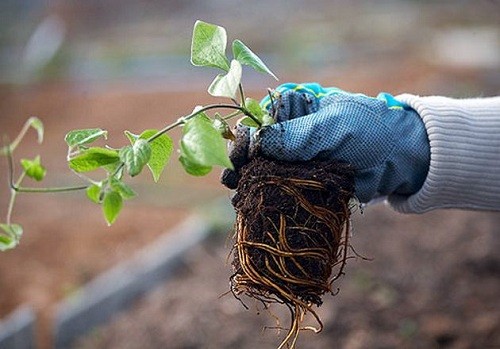
If Clematis is bogko and growing lifestyle, gets a dense thick crown, after 4 - 5 years after landing, it can be seeded. Make it in early spring before the commemoration of the growing season. One plant is divided into the same shrubs in size, leaving at each 2 - 3 kidneys. Slowly growing seedlings after planting can be seen in the growth stimulator, for example, "heteroacexin".
Clematis loves for its long-lasting blossom - spectacular flowers please the eyes from mid-June to the first frost. It is impossible to shrub grow in one place for more than 10 years. For beautiful and lush flowering, it is updated and transplant every 7 years.
![1680x1050_524953_ [www.artfile.ru]](https://recn.ru/images/recn/2015/03/1680x1050_524953_www.artfile.ru_-500x307.jpg)
Care for clematis
Timely weeding, soil breaking, sufficient watering and fertilizer - these are the main components of the buoy flowering of Clematis. For insufficient care, the plant reacts, partially dropping the crown.
Clematis does not tolerate abundant irrigation - one bush should "drink" no more than one bucket of water. But with age, the need of plants increase in moisture increases, and Clematis is watered at the rate of 5 - 7 buckets of water on one bush so that the soil is impregnated with 60 - 70 cm deep. The shrub can not be watered under the very root, otherwise Clematis threatens the development of clicuned rot. Excessive watering and lack of moisture affect the plant equally: the color of the leaves becomes less saturated, the flowers decrease in the amount of yes and the color of Clematis begins less than the limited period.
Mineral fertilizers shrub feed from 4 to 5 times in the season. In May, it is urea or diluted manure, before flowering and be sure after it is an organic agent. In order for the plant to bloom very abundantly, it is sprayed with a fertilizer "Bud" up to 3 times over the summer.
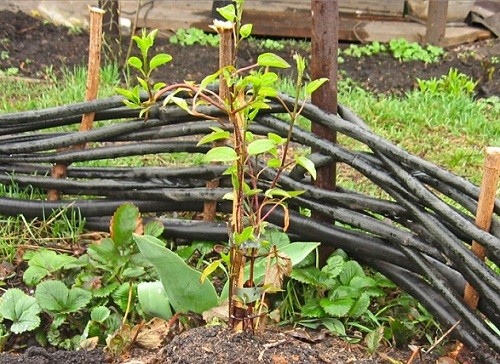
Crossing Clematis
Depending on the time of the dissolution of the first colors, several groups of Clematis distinguish between each of which has its own specific features. We will give a few rules of trimming, which are common to all kinds of shrubs.
In the fall, when the first vegetation of the plant ends, the closures of Clematis are cut to the first kidney. Make it so that the shrub is more active than the new shoots next spring. If the first trimming does not bring the desired result, the plant is cut off once again, cutting off to almost the root.
With the help of trimming, it is possible to change the direction of the growth of Clematis. From the second year of the life of the shrub in parallel with the pruning pinching it. After each cut, the secator is disinfected by a special solution.
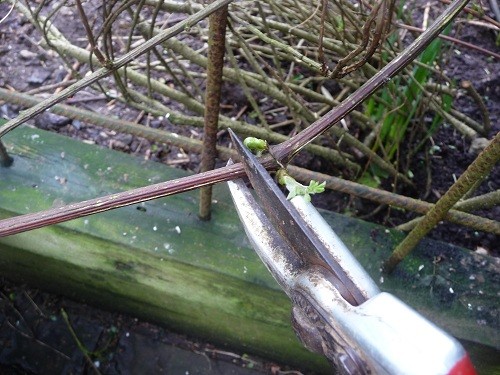
How to winter Clematis
Clematis is a frost-resistant shrub, but on the eve of the cold season of the year without human assistance he can not do. Properly insulated clematis are not afraid of the temperature below 35 ° C!
With the arrival of the first frosts, the plant is not in a hurry to warm - it must first acclimatize. Then choose the vests of dry day and cover the closets with a sweetheart. Then they are wrapped with a dense polyethylene film or erected over each bush a kind of houses from several bars and agrospan. In the spring, the insulation of the coating is removed before the beginning of the vegetation, after having previously convinced that freezers will no longer be.
The reproduction of Clematis
Most often, Clematis is breeding, making chains from an adult growing bush. Engaged in June. The base of the bush is looking for a strong young escape and, having estimated its length, swell the groove suitable in size. All the escape is buried in the ground, leaving only his top hanging. Only escape stems are cheered - young leaves should remain over the ground. The glasses regularly and moderately watered, following the soil always remained moist. Without fertilizer, it is also not to do - the growing escape feed 2 - 3 times. Closer to the fall, the gods will acquire their own roots, the young shoots will be emptied in the spring. In September, the drains are separated from the royal bush to dig, divide into several bushes and transplant to the place allotted for them.
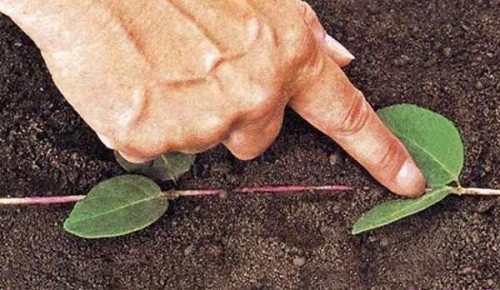
The extension method allows you to breed Clematis very quickly. To do this, you need to choose 3 - a 4-bit bush that has not yet started blossoming. The cuttings are taken from the middle part of the escape with one node of at least 4 - 5 cm at an altitude of about 35 - 40 cm from the ground. On the eve of the landing of the cutlets put in a special aqueous solution, stimulating the growth of plants, and withstand about a day in it. For the winter, the cuttings are hiding under the box and insulate the fallen foliage. The next spring they will be ready for a transplant to a permanent place.
Clematis in landscape design: specifics and advantages of vertical landscaping
Reception of vertical landscaping carries not only decorative, but also a purely practical semantic load. The sad wall of the building, an unsightly economic building on a plot, an inesthetical fence is asked so that they are hidden under the scenic cape of Liana or the curving shrub! And how I want to breathe out from all over the world a living wall of luxurious colors in a secluded corner of the garden! And Clematis will easily give you this opportunity.
Clematis clinks clink up to any support - this explains the popularity of their use in vertical landscaping of a particular object. But this method of garden design has other advantages:
- High level of decorative Clematis.
- Clematis increases magnificently, thanks to which the landscaped area increases even with the most modest size of the site.
- The thick live wall of the climbing plant on the fence will increase sound insulation on the site.
- Vertical gardening creates a new ecological habitat for various fauna representatives.
- Clematis, whining a gazebo or veranda, will protect it in a hot day from the scorching rays of the sun.
- A wide variety of shapes and shades of Clematis colors allows you to implement the most bold design solutions.
We note the disadvantages of vertical landscaping:
- The thick chosen cover of the climbing plant can accumulate dampness, in connection with this, Clematis should not be breeding on the walls of houses, "looking" to the north and north-west.
- Clematis Liana, growing on the roof, can cause clogged gutter.
- Clematis, framing windows, does not pass into the room enough light.
Ways to design a plot with Clematis
Most often, the plant is used as:
- fence for the household site - a live fence will protect private ownership from strangers;
- decoration of the stems of old trees;
- decorative element on the walls of residential buildings and household buildings, fences, arches and arbors;
- background when creating a flower garden;
- flower for single "spontaneous" landings;
- flower for growing in a decorative vase;
- framing of mountaineering and alley.
Floral vertical "canvas" in the garden look amazing - Clematis in landscape design in the photo of this confirmation.




